Influence of Mg Content on the Corrosion Behavior and Precipitation of Aged Al-Cu-Li-xMg Alloys
Abstract
:1. Introduction
2. Experimental
2.1. Material Preparation
2.2. IGC Tests
2.3. Electrochemical Tests
2.4. Characterization
2.5. DSC Measurement
3. Results
3.1. Electrochemical Performance
3.2. Corrosion Modes and IGC Microstructure
3.3. Microstructure
3.4. DSC
4. Discussion
4.1. OCP, Microstructure and Corrosion Mode with the Aging Process
4.2. OCP, Microstructure, Corrosion Mode with Mg Content
5. Conclusions
- (1)
- The concentration of Mg has an important effect on the aging precipitates. The T1 precipitates are dramatically accelerated and θ′ precipitates can be significantly obstructed with the addition of medium Mg. It is worth mentioning that the process of T1 precipitates was prevented in the alloy with excessive Mg.
- (2)
- The interaction between the low potential of Mg and the acceleration of T1 precipitates produced a negative OCP value in Mg-containing alloys at the early stages of aging. Similarly, the Ecorr of Al–Cu–Li alloy with various Mg content decreased with the aging process and Mg content.
- (3)
- The conversion of the corrosion mode in the Al–Cu–Li alloys is caused by variations in the precipitates at the grain and grain boundaries. Firstly, continuous grain boundaries and low levels of precipitation in the grain result in IGC. Secondly, continuous grain boundaries and higher levels of precipitation in the grain produce pitting 2. Finally, discontinuous precipitates in grain boundaries and higher levels of precipitates in the grain produce pitting 1. The corrosion mode exhibited a similar pattern, from local IGC to pitting with age and time.
- (4)
- The 1.1Mg alloy displayed higher polarization resistance and a lower corrosion rate than the Mg-free alloy and 0.7Mg alloy, which shows that excessive Mg (1.1 wt.%) is beneficial to the corrosion protection of Al–Cu–Li alloys.
Author Contributions
Funding
Data Availability Statement
Acknowledgments
Conflicts of Interest
References
- Rioja, R.; Liu, J. The evolution of Al-Li base products for aerospace and space applications. Metall. Mater. Trans. A 2012, 43, 3325–3337. [Google Scholar] [CrossRef]
- Chen, Y.; Pan, S.P.; Liu, W.; Liu, X.; Tang, C.P. Morphologies, orientation relationships, and evolution of the T-phase in an Al-Cu-Mg-Mn alloy during homogenization. J. Alloy. Compd. 2017, 709, 213–226. [Google Scholar] [CrossRef]
- Arbo, S.; Tomovic-Petrovic, S.; Aunemo, J.; Dahle, N.; Jensrud, O. On weldability of aerospace grade Al-Cu-Li alloy AA2065 by wire-feed laser metal deposition. J. Adv. Join. Process. 2022, 5, 100096. [Google Scholar] [CrossRef]
- Dursun, T.; Soutis, C. Recent developments in advanced aircraft aluminium alloys. Mater. Des. 2014, 56, 862–871. [Google Scholar] [CrossRef]
- Yin, D.Y.; Liu, H.Q.; Chen, Y.Q.; Yi, D.Q.; Wang, B.; Wang, B.; Shen, F.H.; Fu, S.; Tang, C.; Pan, S.P. Effect of grain size on fatigue-crack growth in 2524 aluminium alloy. Int. J. Fatigue 2016, 84, 9–16. [Google Scholar] [CrossRef]
- El-Aty, A.A.; Xu, Y.; Guo, X.Z.; Zhang, S.H.; Ma, Y.; Chen, D.Y. Strengthening mechanisms, deformation behavior, and anisotropic mechanical properties of Al-Li alloys: A review. J. Adv. Res. 2018, 10, 49–67. [Google Scholar] [CrossRef]
- Zhang, R.; Qiu, Y.; Qi, Y.; Birbilis, N. A closer inspection of a grain boundary immune to intergranular corrosion in a sensitised Al-Mg alloy. Corros. Sci. 2018, 133, 1–5. [Google Scholar] [CrossRef]
- Donatus, U.; Terada, M.; Ospina, C.R.; Queiroz, F.M. On the AA2198-T851 alloy microstructure and its correlation with localized corrosion behaviour. Corros. Sci. 2018, 131, 300–309. [Google Scholar] [CrossRef]
- Ma, Y.; Zhou, X.; Huang, W.; Thompson, G.E.; Zhang, X.; Luo, C.; Sun, Z. Localized corrosion in AA2099-T83 aluminum-lithium alloy: The role of intermetallic particles. Mater. Chem. Phys. 2015, 161, 201–210. [Google Scholar] [CrossRef]
- Zhang, X.; Lv, Y.; Zhou, X.; Hashimoto, T.; Ma, Y. Corrosion behaviour of 2A97-T8 Al-Cu-Li alloy extrusion. J. Alloy. Compd. 2022, 898, 162872. [Google Scholar] [CrossRef]
- Ren, W.; Li, J.F.; Zheng, Z.Q.; Chen, W. Localized corrosion mechanism associated with precipitates containing Mg in Al alloys. Trans. Nonferrous Met. Soc. China 2007, 17, 727–732. [Google Scholar] [CrossRef]
- Buchheit, R.G.; Moran, J.P.; Stoner, G.E. Localized corrosion behavior of alloy 2090-the role of microstructural heterogeneity. Corrosion 1990, 46, 610–617. [Google Scholar] [CrossRef]
- Lin, Y.; Lu, C.; Wei, C.; Zheng, Z. Effect of aging treatment on microstructures, tensile properties and intergranular corrosion behavior of Al-Cu-Li alloy. Mater. Charact. 2018, 141, 163–168. [Google Scholar] [CrossRef]
- Yin, D.; Xiao, Q.; Chen, Y.; Liu, H.; Yi, D.; Wang, B.; Pan, S. Effect of natural ageing and pre-straining on the hardening behaviour and microstructural response during artificial ageing of an Al-Mg-Si-Cu alloy. Mater. Des. 2016, 95, 329–339. [Google Scholar] [CrossRef]
- Li, J.F.; Zheng, Z.Q.; Ren, W.; Chen, W.; Zhao, X.; Li, S. Simulation on function mechanism of T1(Al2CuLi) precipitate in localized corrosion of Al-Cu-Li alloys. Trans. Nonferrous Met. Soc. China 2006, 16, 1268–1273. [Google Scholar] [CrossRef]
- Proton, V.; Alexis, J.; Andrieu, E.; Delfosse, J.; Deschamps, A.; De Geuser, F.; Lafont, M.C.; Blanc, C. The influence of artificial ageing on the corrosion behaviour of a 2050 aluminium-copper-lithium alloy. Corros. Sci. 2014, 80, 494–502. [Google Scholar] [CrossRef]
- de Sousa Araujo, J.; Donatus, U.; Queiroz, F.M.; Terada, M.; Milagre, M.X.; de Alencar, M.C.; Costa, I. On the severe localized corrosion susceptibility of the AA2198-T851 alloy. Corros. Sci. 2018, 133, 132–140. [Google Scholar] [CrossRef]
- Li, J.F.; Zheng, Z.Q.; Na, J.; Chengyu, T. Chengyu, Localized corrosion mechanism of 2×××-series Al alloy containing S(Al2CuMg) and θ′(Al2Cu) precipitates in 4.0% NaCl solution at pH 6.1. Mater. Chem. Phys. 2005, 91, 325–329. [Google Scholar] [CrossRef]
- Zhang, X.; Zhou, X.; Hashimoto, T.; Lindsay, J.; Ciuca, O.; Luo, C.; Sun, Z.; Zhang, X.; Tang, Z. The influence of grain structure on the corrosion behaviour of 2A97-T3 Al-Cu-Li alloy. Corros. Sci. 2017, 116, 14–21. [Google Scholar] [CrossRef]
- Zhang, X.; Zhou, X.; Hashimoto, T.; Liu, B.; Luo, C.; Sun, Z.; Lu, F.; Ma, Y. Corrosion behaviour of 2A97-T6 Al-Cu-Li alloy: The influence of non-uniform precipitation. Corros. Sci. 2018, 132, 1–8. [Google Scholar] [CrossRef]
- Jiang, B.; Wang, C.; Song, R.; Li, S.; Cao, F.; Yi, D. Effect of creep ageing on the corrosion behaviour of an Al-Cu-Li alloy. Corros. Sci. 2022, 202, 110314. [Google Scholar] [CrossRef]
- Zhu, Y.; Poplawsky, J.D.; Li, S.; Unocic, R.R.; Bland, L.G.; Taylor, C.D.; Locke, J.S.; Marquis, E.A.; Frankel, G.S. Localized corrosion at nm-scale hardening precipitates in Al-Cu-Li alloys. Acta Mater. 2020, 189, 204–213. [Google Scholar] [CrossRef]
- Li, J.; Birbilis, N.; Liu, D.Y.; Chen, Y.L.; Zhang, X.H.; Cai, C. Intergranular corrosion of Zn-free and Zn-microalloyed Al–xCu–yLi alloys. Corros. Sci. 2016, 105, 44–57. [Google Scholar] [CrossRef]
- Huang, L.; Huang, J.; Liu, W.; Cao, L.; Li, S. Effect of minor Sc additions on precipitation and mechanical properties of a new Al-Cu-Li alloy under T8 temper. J. Alloy. Compd. 2022, 927, 166860. [Google Scholar] [CrossRef]
- Itoh, G.; Cui, Q.; Kanno, M. Effects of a small addition of magnesium and silver on the precipitation of T1 phase in an Al-4%Cu-1.1%Li-0.2%Zr alloy. Mater. Sci. Eng. A 1996, 211, 128–137. [Google Scholar] [CrossRef]
- Murayama, M.; Hono, K. Role of Ag and Mg on precipitation of T1 phase in an Al-Cu-Li-Mg-Ag alloy. Scr. Mater. 2001, 44, 701–706. [Google Scholar] [CrossRef]
- Gumbmann, E.; Lefebvre, W.; Deschamps, A. The effect of minor solute additions on the precipitation path of an Al-Cu-Li alloy. Acta Mater. 2016, 115, 104–114. [Google Scholar] [CrossRef]
- Donnadieu, P.; Shao, Y.; De Geuser, F.; Botton, G.A.; Lazar, S.; Cheynet, M.; de Boissieu, M.; Deschamps, A. Atomic structure of T1 precipitates in Al-Li-Cu alloys revisited with HAADF-STEM imaging and small-angle X-ray scattering. Acta Mater. 2011, 59, 462–472. [Google Scholar] [CrossRef]
- Wang, X.M.; Li, G.A.; Jiang, J.T.; Shao, W.Z.; Zhen, L. Influence of Mg content on ageing precipitation behavior of Al-Cu-Li-x alloys. Mater. Sci. Eng. A 2019, 742, 138–149. [Google Scholar] [CrossRef]
- Liu, Z.Z.; Li, J.F.; Liu, D.; Ma, Y.; Du, Y.; Chen, Y.; Zhang, X.; Gupta, R.K.; Chen, X.; Zhang, R. Sluggish precipitation strengthening in Al-Li alloy with a high concentration of Mg. J. Mater. Res. Technol. 2021, 11, 1806–1815. [Google Scholar] [CrossRef]
- Ning, H.; Li, J.F.; Ma, P.C.; Chen, Y.L.; Zhang, R.F. Evolution of aging precipitates in an Al-Li alloy with 1.5 wt% Li concentration. Vacuum 2020, 182, 109677. [Google Scholar] [CrossRef]
- Li, J.F.; Li, C.X.; Peng, Z.W.; Chen, W.J.; Zheng, Z.Q. Corrosion mechanism associated with T1 and T2 precipitates of Al-Cu-Li alloys in NaCl solution. J. Alloy. Compd. 2008, 460, 688–693. [Google Scholar] [CrossRef]
- Huang, J.Y.; Ming, W.Q.; Wu, C.L. Effect of microstructure on corrosion behaviour of Al-Cu-Li alloys. Mater. Charact. 2022, 194, 112416. [Google Scholar] [CrossRef]
- Zhang, R.F.; Li, J.F.; Li, Q.; Qi, Y.S.; Zeng, Z.R.; Qiu, Y.; Chen, X.B.; Kairy, S.K.; Thomas, S.; Birbilis, N. Analysing the degree of sensitisation in 5xxx series aluminium alloys using artificial neural networks: A tool for alloy design. Corros. Sci. 2019, 150, 268–278. [Google Scholar] [CrossRef]
- Gumbmann, E.; De Geuser, F.; Sigli, C.; Deschamps, A. Influence of Mg, Ag and Zn minor solute additions on the precipitation kinetics and strengthening of an Al-Cu-Li alloy. Acta Mater. 2017, 133, 172–185. [Google Scholar] [CrossRef]
- da Silva, R.M.P.; Milagre, M.X.; Izquierdo, J.; Betancor-Abreu, A.M.; de Oliveira, L.A.; Araujo, J.V.d.S.; Antunes, R.A.; Souto, R.M.; Costa, I. Surface finishing effects on the corrosion behavior and electrochemical activity of 2098-T351 aluminum alloy investigated using scanning microelectrochemical techniques. Mater. Charact. 2022, 191, 112130. [Google Scholar] [CrossRef]
- Dorin, T.; Deschamps, A.; De Geuser, F.; Lefebvre, W.; Sigli, C. Quantitative description of the T1 formation kinetics in an Al-Cu-Li alloy using differential scanning calorimetry, small-angle X-ray scattering and transmission electron microscopy. Philos. Mag. 2014, 94, 1012–1030. [Google Scholar] [CrossRef]
- Araullo Peters, V.; Gault, B.; Cairney, J.; Deschamps, A.; Cairney, J.M. Microstructural evolution during ageing of Al-Cu-Li-x alloys. Acta Mater. 2014, 66, 199–208. [Google Scholar] [CrossRef]
- Decreus, B.; Deschamps, A.; De Geuser, F.; Donnadieu, P.; Sigli, C.; Weyland, M. The influence of Cu/Li ratio on precipitation in Al-Cu-Li-x alloys. Acta Mater. 2013, 61, 2207–2218. [Google Scholar] [CrossRef]
- Davó, B.; de Damborenea, J.J. Use of rare earth salts as electrochemical corrosion inhibitors for an Al-Li-Cu (8090) alloy in 3.56% NaCl. Electrochim. Acta 2004, 49, 4957–4965. [Google Scholar] [CrossRef]
- Holscher, A.A. A field emission retarding potential method for measuring work functions. Surf. Sci. 1966, 4, 89–102. [Google Scholar] [CrossRef]
- Strayer, R.W.; Mackie, W.; Swanson, L. Work function measurements by the field emission retarding potential method. Surf. Sci. 1973, 34, 225–248. [Google Scholar] [CrossRef]
- Buchheit, R.G.; Grant, R.P.; Hlava, P.F. Local dissolution phenomena associated with S Phase (Al2CuMg) particles in aluminum alloy 2024. J. Electrochem. Soc. 1997, 8, 2621–2627. [Google Scholar] [CrossRef]
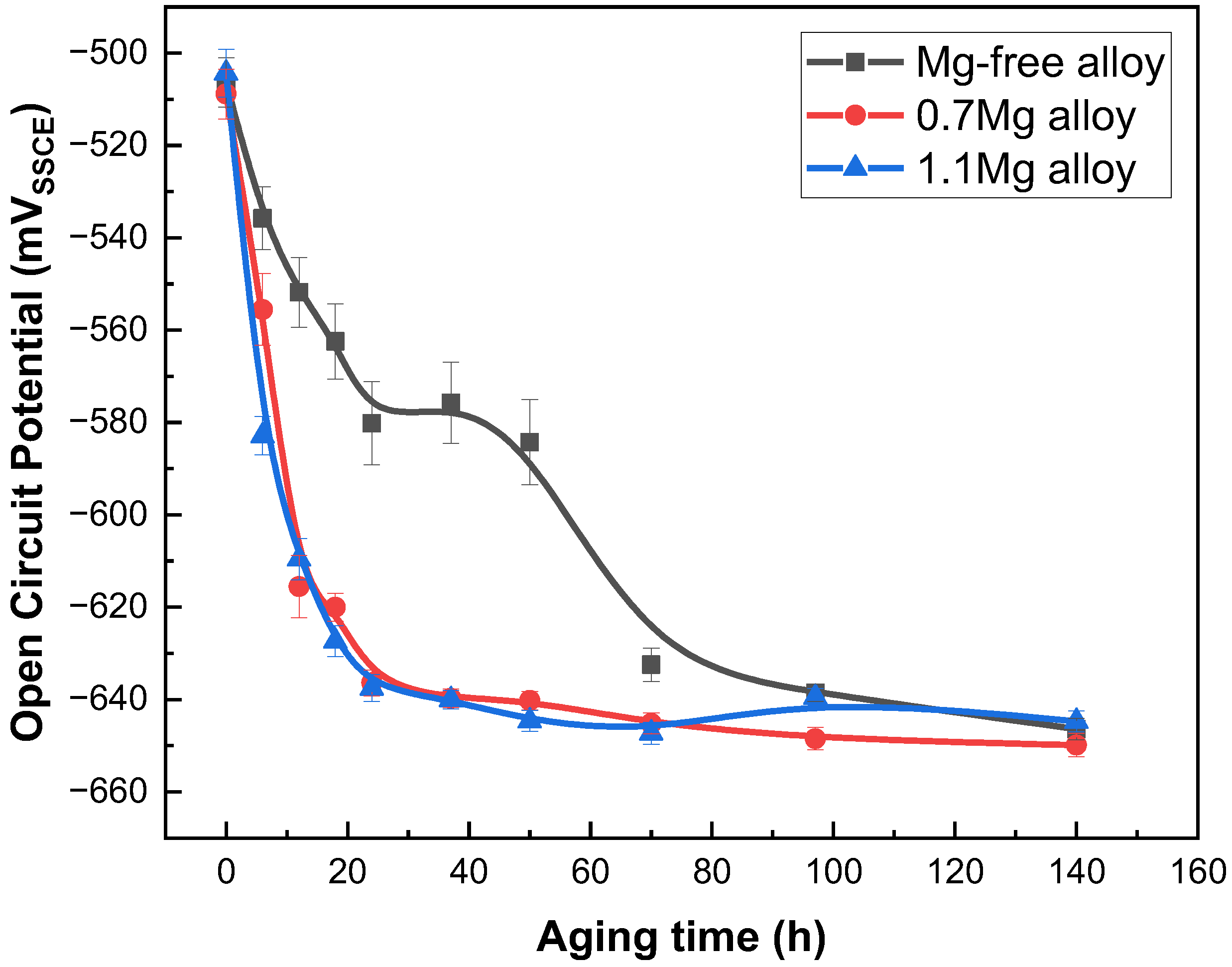
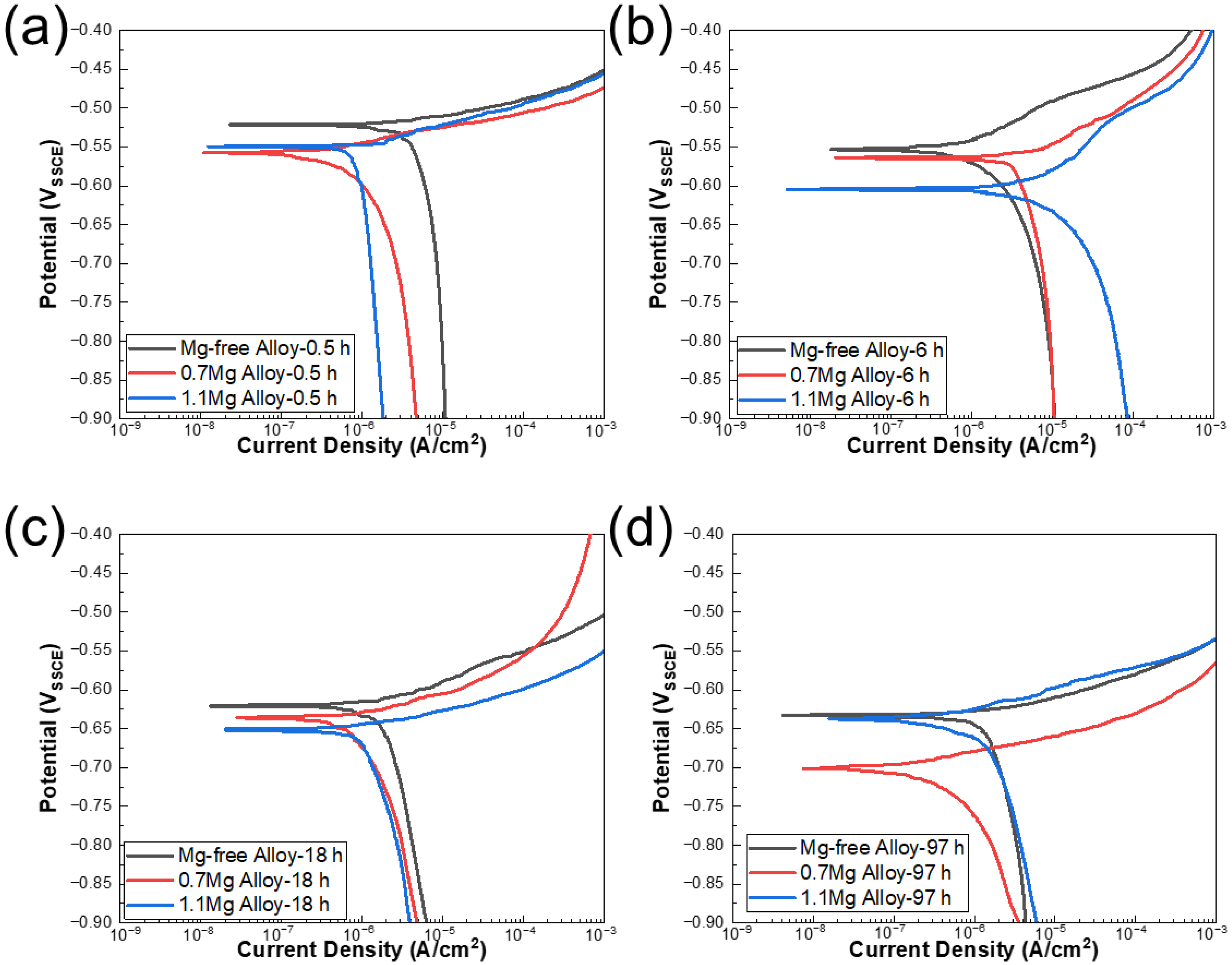
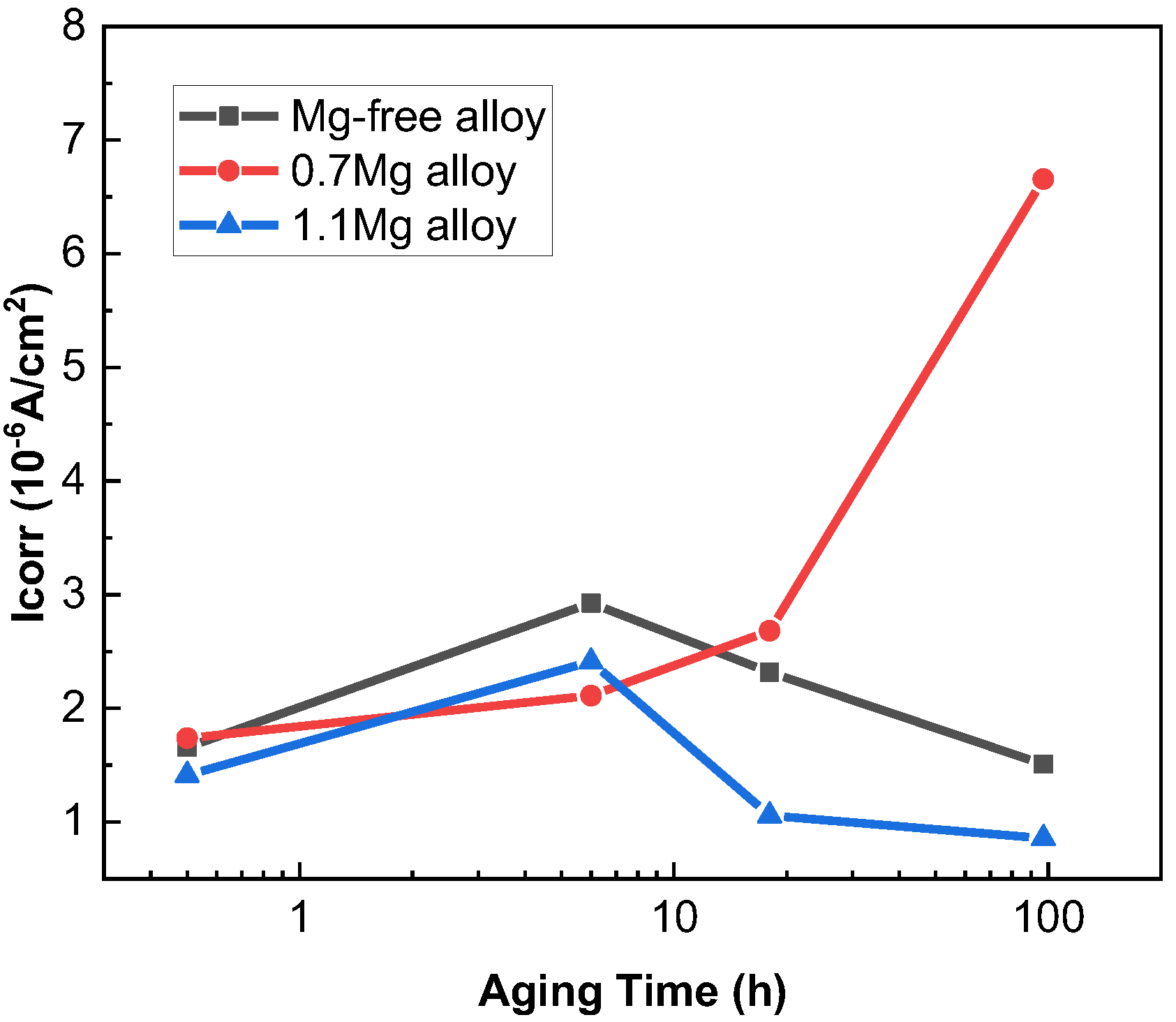
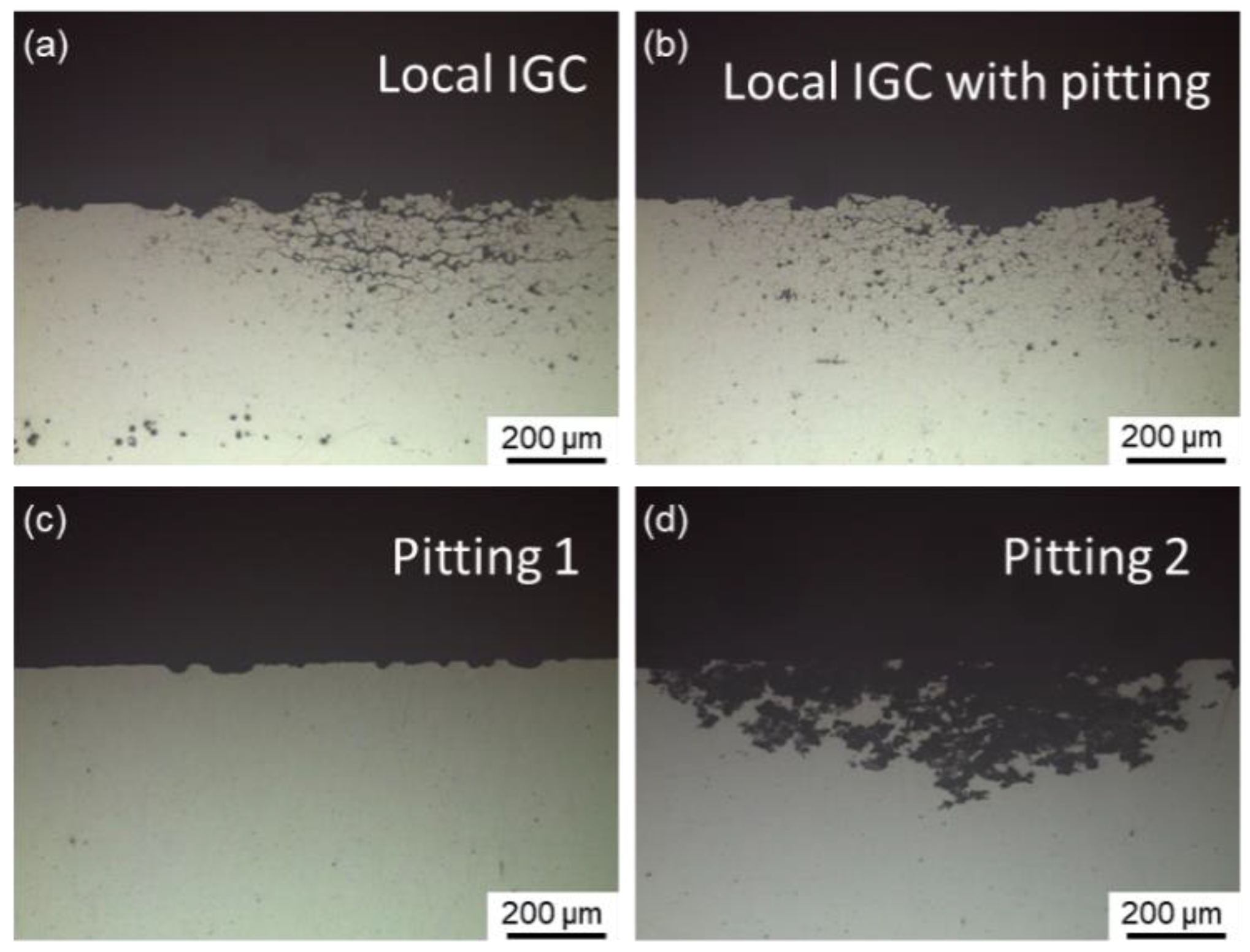

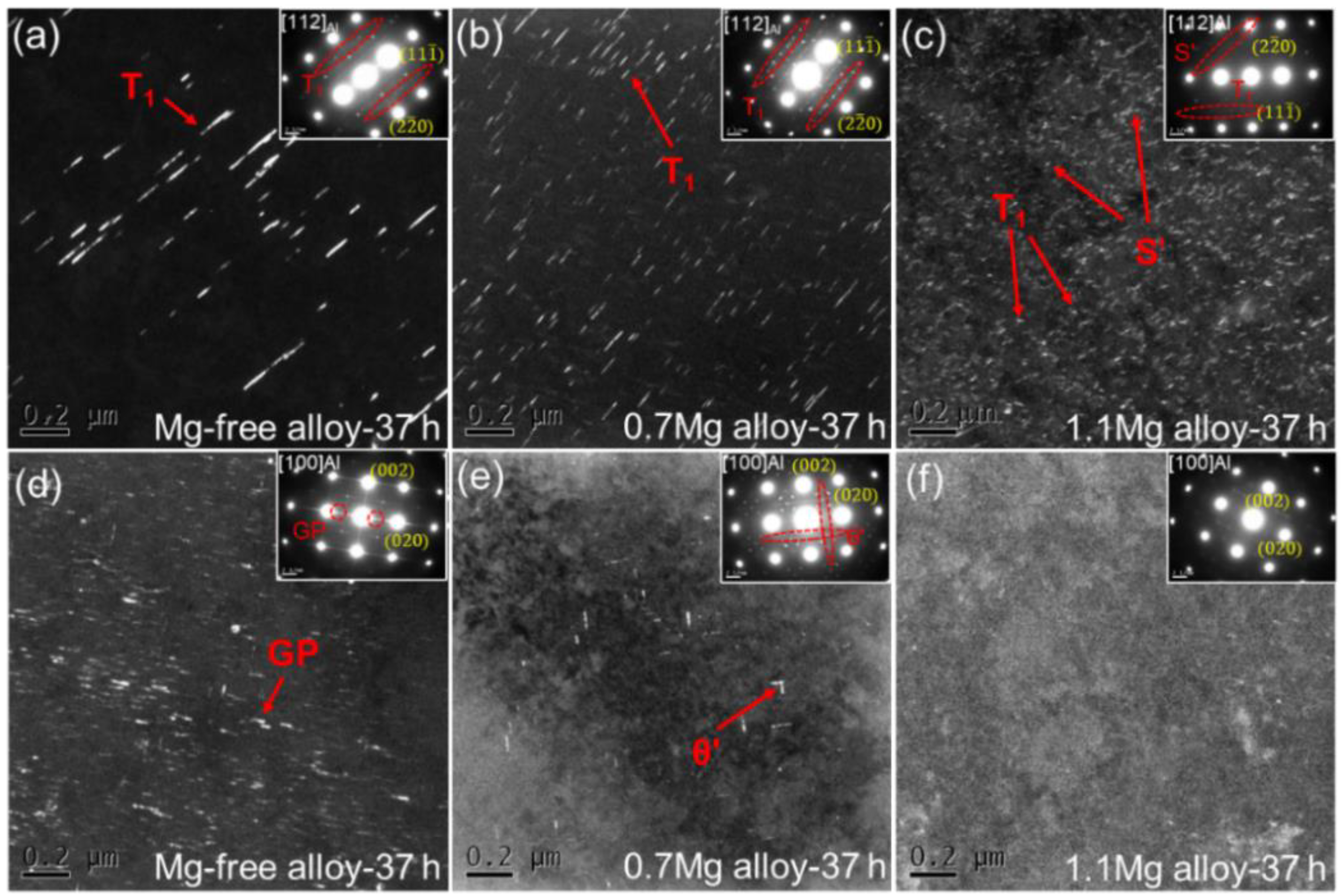
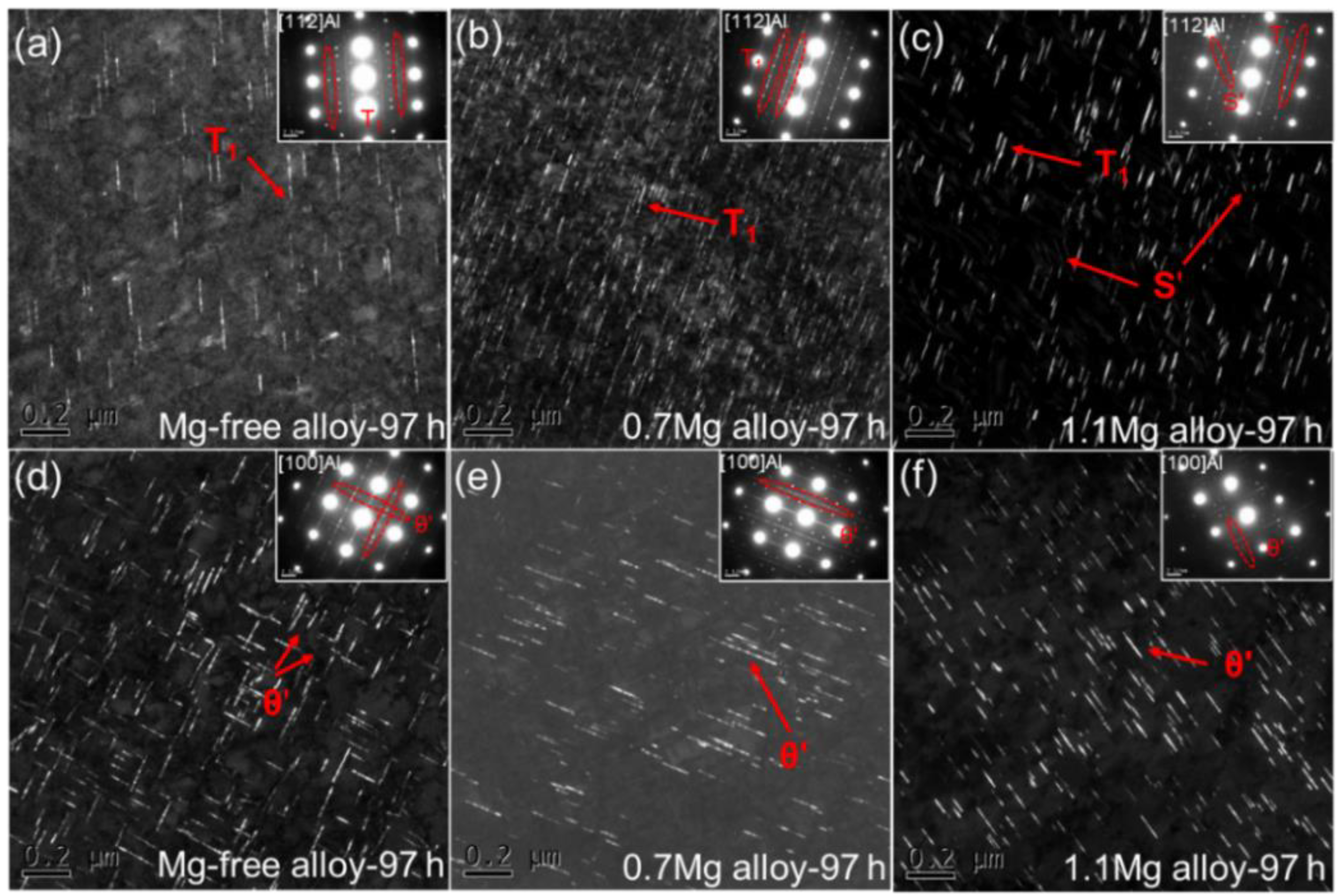
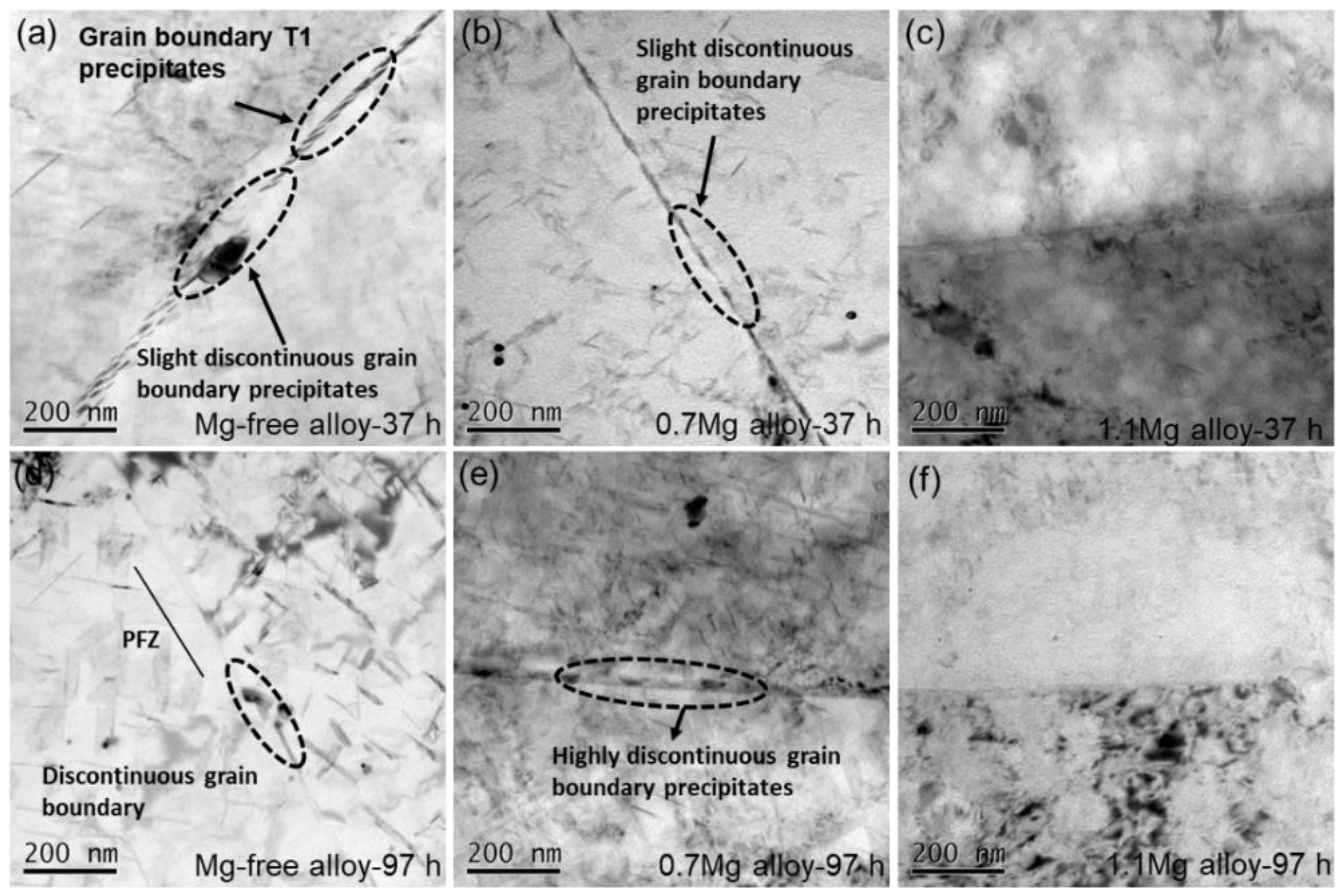
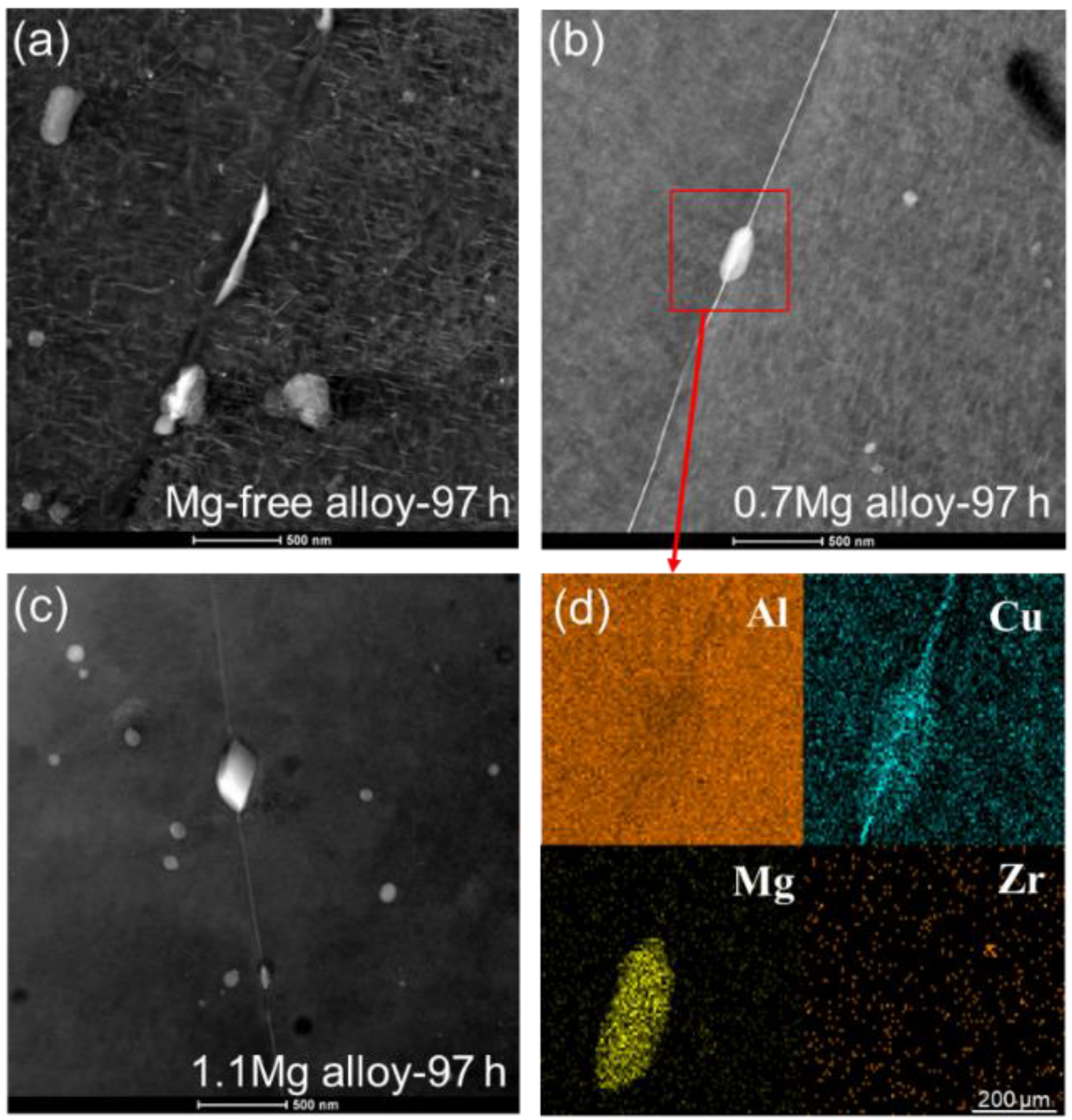
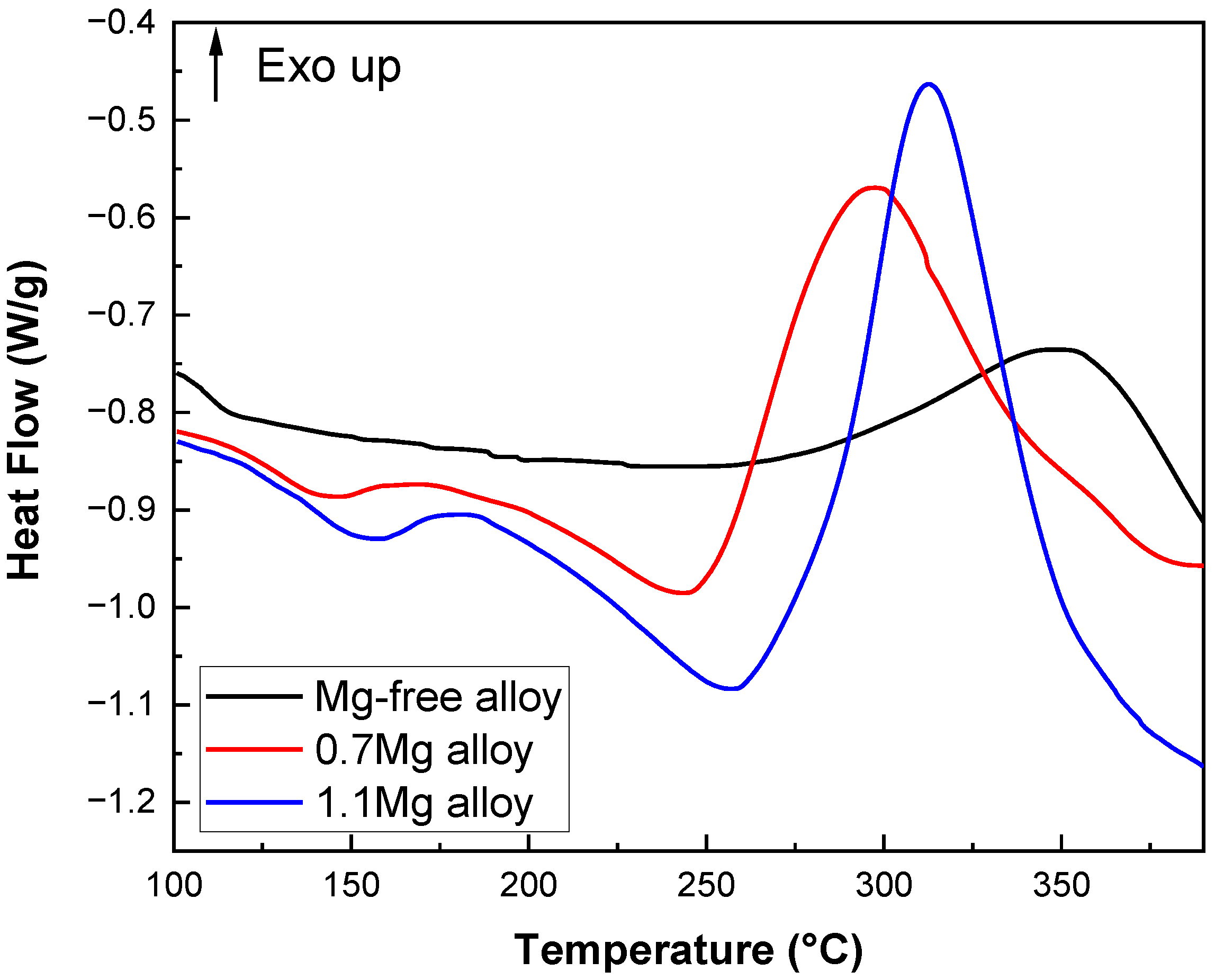
| Alloy | Cu | Li | Mg | Ag | Zn | Mn | Zr | Al |
|---|---|---|---|---|---|---|---|---|
| Mg-free alloy | 3.92 | 0.88 | - | 0.26 | 0.47 | 0.31 | 0.12 | Bal. |
| 0.7Mg alloy | 3.92 | 0.76 | 0.68 | 0.26 | 0.47 | 0.32 | 0.12 | Bal. |
| 1.1Mg alloy | 3.92 | 0.85 | 1.04 | 0.26 | 0.47 | 0.31 | 0.12 | Bal. |
| Time (h) | Alloy | Ecorr (VSSCE) | Icorr (10−6 A/cm2) | Anodic Slopes (V/A) | Cathodic Slopes (V/A) | Rp (Ω/cm2) | Corrosion Rate (mm/year) |
|---|---|---|---|---|---|---|---|
| 0.5 | Mg-free alloy | −0.521 | 1.657 | 0.008 | 0.03 | 1657 | 0.058 |
| 0.7Mg alloy | −0.557 | 1.738 | 0.01 | 0.03 | 1876 | 0.061 | |
| 1.1Mg alloy | −0.549 | 1.413 | 0.007 | 0.1 | 2013 | 0.049 | |
| 6 | Mg-free alloy | −0.553 | 2.926 | 0.04 | 0.03 | 2547 | 0.102 |
| 0.7Mg alloy | −0.557 | 2.11 | 0.01 | 0.05 | 1717 | 0.074 | |
| 1.1Mg alloy | −0.604 | 2.410 | 0.17 | 0.04 | 5841 | 0.084 | |
| 18 | Mg-free alloy | −0.621 | 2.317 | 0.05 | 1.21 | 9010 | 0.081 |
| 0.7Mg alloy | −0.637 | 2.681 | 0.04 | 0.37 | 5854 | 0.094 | |
| 1.1Mg alloy | −0.652 | 1.056 | 0.03 | 0.37 | 11,425 | 0.037 | |
| 97 | Mg-free alloy | −0.633 | 1.509 | 0.03 | 0.49 | 8145 | 0.053 |
| 0.7Mg alloy | −0.702 | 6.656 | 0.03 | 0.24 | 1741 | 0.232 | |
| 1.1Mg alloy | −0.638 | 0.857 | 0.03 | 0.26 | 13,645 | 0.030 |
| Alloy | Aging Time (h) | Corrosion Mode | Maximum IGC Depth/μm | Average IGC Depth/μm | Maximum Pitting Depth/μm | Average Pitting Depth/μm |
|---|---|---|---|---|---|---|
| Mg-free alloy | 0.5 | Local IGC with pitting 1 | 155.7 | 130.6 | 170.8 | 143.3 |
| 1 | Local IGC with pitting 1 | 221.7 | 208.4 | 205.8 | 190.6 | |
| 2 | Local IGC with pitting 1 | 318.9 | 265.2 | 242.1 | 193.1 | |
| 4 | Local IGC with pitting 1 | 264.1 | 208.6 | 260.5 | 191.4 | |
| 6 | Local IGC with pitting 2 | 204.7 | 166.9 | 93.6 | 82.5 | |
| 12 | Pitting 2 | - | - | 102.9 | 90.5 | |
| 18 | Pitting 2 | - | - | 163.7 | 141.1 | |
| 24 | Pitting 2 | - | - | 113.5 | 97.1 | |
| 37 | Pitting 2 | - | - | 174.3 | 152.3 | |
| 50 | Pitting 2 | - | - | 204.7 | 181.5 | |
| 70 | Pitting 2 | - | - | 262.8 | 187.3 | |
| 97 | Pitting 1 | - | - | 34.5 | 25.9 | |
| 140 | Pitting 1 | - | - | 19.9 | 16.8 | |
| 0.7Mg alloy | 0.5 | Local IGC with pitting 1 | 429.1 | 317.7 | 220.8 | 210.7 |
| 1 | Local IGC with pitting 1 | 345.9 | 264.6 | 158.8 | 135.5 | |
| 2 | Local IGC with pitting 1 | 324.8 | 259.3 | 122.2 | 77.7 | |
| 4 | Local IGC with pitting 1 | 401.2 | 325.9 | 88.5 | 72.7 | |
| 6 | Pitting 2 | - | - | 101.8 | 85.8 | |
| 12 | Pitting 2 | - | - | 108.1 | 171.5 | |
| 18 | Pitting 2 | - | - | 182.7 | 141.5 | |
| 24 | Pitting 2 | - | - | 241.2 | 212.3 | |
| 37 | Pitting 2 | - | - | 261.6 | 191.4 | |
| 50 | Pitting 2 | - | - | 293.2 | 243.7 | |
| 70 | Pitting 2 | - | - | 205.8 | 197.6 | |
| 97 | Pitting 2 | - | - | 185.7 | 147.8 | |
| 140 | Pitting 2 | - | - | 217.3 | 156.1 | |
| 1.1Mg alloy | 0.5 | Local IGC with pitting 1 | 447.1 | 368.7 | - | - |
| 1 | Local IGC with pitting 1 | 449.9 | 354.3 | - | - | |
| 2 | Local IGC with pitting 1 | 449.7 | 368.0 | 101.7 | 86.7 | |
| 4 | Local IGC with pitting 1 | 447.9 | 419.5 | 263.7 | 193.3 | |
| 6 | Local IGC with pitting 1 | 290.1 | 225.6 | 44.4 | 29.4 | |
| 12 | Local IGC with pitting 1 | 351.6 | 301.1 | 89.9 | 75.1 | |
| 18 | Pitting 1 | - | - | 35.5 | 25.8 | |
| 24 | Pitting 1 | - | - | 30.1 | 27.5 | |
| 37 | Pitting 1 | - | - | 27.5 | 22.2 | |
| 50 | Pitting 1 | - | - | 46.2 | 38.8 | |
| 70 | Pitting 1 | - | - | 64.9 | 48.2 | |
| 97 | Pitting 1 | - | - | 80.3 | 56.1 | |
| 140 | Pitting 1 | - | - | 147.2 | 74.6 |
| Phase | Ecorr (VSSCE) | Icorr (A/cm2) |
|---|---|---|
| T1 | −1.751 | 1.02 × 10−4 |
| Al | −0.900 | 9.0 × 10−6 |
| θ′ | −0.744 | 1 × 10−6 |
Disclaimer/Publisher’s Note: The statements, opinions and data contained in all publications are solely those of the individual author(s) and contributor(s) and not of MDPI and/or the editor(s). MDPI and/or the editor(s) disclaim responsibility for any injury to people or property resulting from any ideas, methods, instructions or products referred to in the content. |
© 2023 by the authors. Licensee MDPI, Basel, Switzerland. This article is an open access article distributed under the terms and conditions of the Creative Commons Attribution (CC BY) license (https://creativecommons.org/licenses/by/4.0/).
Share and Cite
Wu, R.; Liu, Z.; Ning, H.; Lu, D.; Liu, Z.; Meng, Y.; Li, J.; Zhang, R. Influence of Mg Content on the Corrosion Behavior and Precipitation of Aged Al-Cu-Li-xMg Alloys. Metals 2023, 13, 341. https://doi.org/10.3390/met13020341
Wu R, Liu Z, Ning H, Lu D, Liu Z, Meng Y, Li J, Zhang R. Influence of Mg Content on the Corrosion Behavior and Precipitation of Aged Al-Cu-Li-xMg Alloys. Metals. 2023; 13(2):341. https://doi.org/10.3390/met13020341
Chicago/Turabian StyleWu, Rong, Zhenzhen Liu, Hong Ning, Dingding Lu, Zhihao Liu, Ya Meng, Jinfeng Li, and Ruifeng Zhang. 2023. "Influence of Mg Content on the Corrosion Behavior and Precipitation of Aged Al-Cu-Li-xMg Alloys" Metals 13, no. 2: 341. https://doi.org/10.3390/met13020341
APA StyleWu, R., Liu, Z., Ning, H., Lu, D., Liu, Z., Meng, Y., Li, J., & Zhang, R. (2023). Influence of Mg Content on the Corrosion Behavior and Precipitation of Aged Al-Cu-Li-xMg Alloys. Metals, 13(2), 341. https://doi.org/10.3390/met13020341






